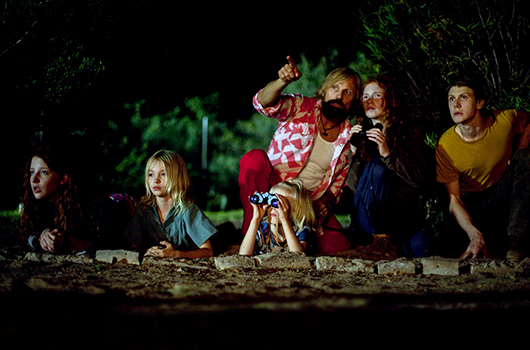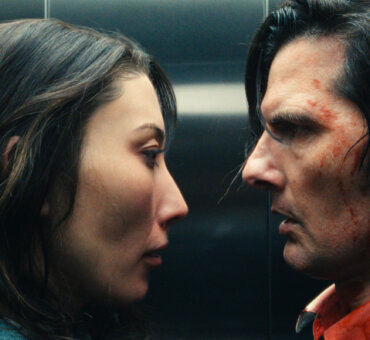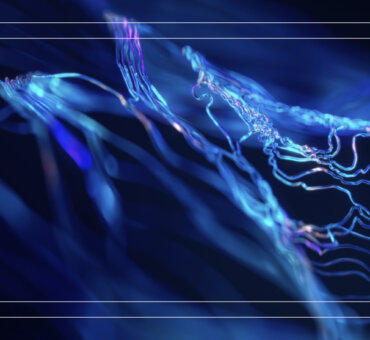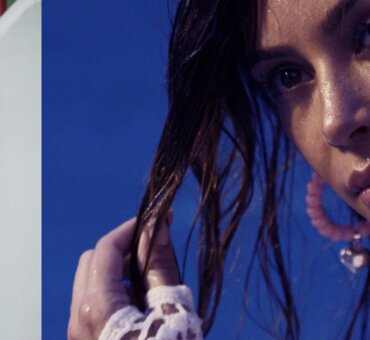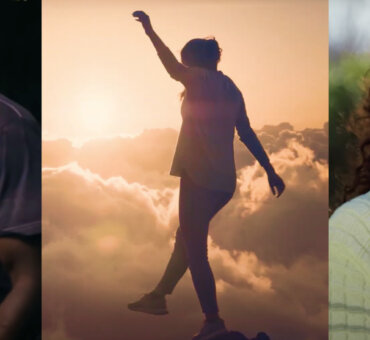When we called editor Joseph Krings, there was a familiar voice in the background. “That was Kevin Spacey,” Joseph said, moving into another room while his co-editors continued refining a scene from their upcoming film Rebel in the Rye, about the infamously reclusive and obsessive writer J. D. Salinger. “We’re working on the final mix now,” Joseph told us, “making some changes between Sundance and its official release.” It reminds us of a quote from poet Paul Valéry: “A poem is never finished; it is only abandoned.” The same could be said about the edit of a film. The refinement process is seemingly asymptotic, changing even decades later for special anniversary releases and remasterings.
In many ways, an editor’s job is a lot like a writer’s. Necessarily obsessive. Occasionally reclusive. “It’s very akin to writing,” Joseph told us. “[But] your job is not to come up with something from scratch. It’s to use your skills to create the best version of the director’s vision on-screen.”
Here’s editor Joseph Krings on beginnings, endings, and his work on the beautifully strange indie classic, Captain Fantastic.
How did you come to work on Captain Fantastic?
So, my first job as a feature film editor was on 28 Hotel Rooms, which was written and directed by Matt Ross. He’s the one who took a chance on me because he had a tiny film that barely had a budget. But we hit it off. And I really wanted to establish myself as an editor, so I was absolutely willing to work for very little money. The film played at Sundance in 2012, and I went on to cut some other movies. Then Matt wrote the script for Captain Fantastic. When the financing and casting came together, he gave me a call and said, “I’ve got my next movie. Are you ready to cut?” And that was pretty much that.
Is that a common scenario?
It’s not always easy to get that first gig, but it’s pretty common for directors to work with the same editors over and over again. It’s a relationship built on loyalty and trust. The editing process is very intimate. You’re seeing everything the director shot for the project. They have to be very open and honest with you about what they want. Matt really went to bat for me. The project was a big jump for him, but it was a really big jump for me. I’d never worked on a union job before. I’d never worked on a film with a budget of over a million dollars. And it wasn’t like he could say, “I want this guy,” and boom it happened. He had to convince people.
How different is it working on a larger scale?
Actually, the challenges are largely the same, but the expectations are so high. It forces you to work at another level.
How involved are you during production? What does it look like to work on the movie?
Well, the ideal way to work — and it doesn’t always work out this way — is for one editor to be involved from pre-production all the way through to the end. Which was the situation with Captain Fantastic. I read many drafts of the script and I gave notes. I think it’s important for the editor to be able to give notes during the script phase, because they see things a different way. They can anticipate challenges that will come up later. Getting those notes before it’s too late for actionable changes can make the final edit less difficult.
Are there typical notes you give as an editor — things that might get overlooked by the production team?
I try to give notes the way an average viewer might. “I think this works; I was confused by this,” etc. But you also might see places where something doesn’t translate from the page to the screen. Sometimes you know from experience that some tiny strand of story is gonna get cut. So I’ll gently suggest they don’t bother with it. Or a lot of times, prior to going into production, a film crew knows what running-time constraints it’s up against. I can provide insight on what will probably be cut. In an ideal world, I want them to shoot everything, and then I’ll deal with it all in the edit room. But that’s not reality. You have only a certain number of days to shoot, so choices have to be made.
Are you involved during the shoot as well?
During production, every day I get the dailies. Depending on where the shoot is, I’ll get a hard drive or the files will come via the internet or whatever. Then I’ll have the day’s shoot the very next morning. That way I can immediately look at what they’ve shot and start putting the scenes together. Those scenes get shared with the director. It’s extremely valuable for them to be able to watch the cut reel, to evaluate a performance, or to see if anything is missing. It also allows me the opportunity to say: “Hey, it looks like yesterday’s shoot was great. But to really make this scene work, it would help if I had this particular insert shot.” Any film with a decent budget will have the editor and the production crew working in tandem. Of course, that’s not possible sometimes. Or sometimes the primary editor on the film isn’t available during some or all of the shoot, so somebody else does that part.
What were your initial impressions of the film as you were first editing together scenes? Was it like, “Oh man, this is really coming together”? Or “Oh, this is gonna take some work”?
A lot of times it’s hard to know. It takes a while to get into the world of the movie. At first you’re just putting it together. But after a while, things start to gel. With Captain Fantastic, I was really familiar with the story because I was brought into the process early. Still, every day surprising things would come in. Viggo Mortensen’s performance was amazing; the kids were all amazing. There was so much good stuff to play with.
Can there be too much good stuff?
Definitely. With Captain Fantastic, there was almost nothing that I didn’t love, so my initial assembly was practically four hours long because I didn’t cut anything. Of course, nobody wants to watch a four-hour film, but it did exist. On the flipside, there’s footage that comes in and you’re like, “This isn’t gonna work the way it’s intended.”
The best example I can give is there was a scene late in Captain Fantastic, during a road trip, when the family gets stuck in a traffic jam. The kids are looking out the windows at all the traffic, and Ben, the father, takes the intercom and starts making a speech about consumerism. It was a much longer speech than what ended up in the movie. But I didn’t think it fit so late in the movie because it was his first time using the intercom. I looked at that and thought, “This doesn’t make sense here.” And the staging seemed a bit off. It didn’t look like bumper-to-bumper traffic they way they’d shot it.
On the other hand, earlier in the film there was a scene where the family leaves the forest, and I thought it was odd that they didn’t say anything about it. They’re just all of a sudden on the road. It’s such a pivotal moment. I felt like that scene needed more of a boost. So I had two scenes that weren’t quite working, and I realized I could repurpose the speech and relocate it to that earlier scene. It was cool to be able to solve one problem with another problem.
Did you ever have to radically change something in the film?
Where we struggled with this film was bringing it in at a reasonable length because, again, we were so in love with everything. The challenge was cutting things down and finding just the right mixture of scenes. We even did feedback screenings that pushed us to make more changes. The raw cut was pretty different from the final release. It ended up being two hours, which is a bit long for what is largely a comedy. But every decision along the way really did make it a better and better film.
Next to screenwriting, editing seems like the most write-y part of filmmaking. You have a lot of control over the story.
Absolutely. It’s very akin to writing. But it’s more of a collaboration because you’re interacting with the director on a day-to-day basis. Your job is not to come up with something from scratch. It’s to use your skills to create the best version of the director’s vision on-screen. You’re limited by the materials, but there are an infinite number of ways in which you can put those materials together.
When I started out, I read books about editing, and some old-school editors would say things like: “In the end, there’s only one right way to edit something. If you give any three editors the same footage, they’ll find the right way to put it together eventually.” I thought that was crazy. Every editor is going to do something different with that material. And they’ll find their right way to do it. But they won’t all come up with the same solution.
Maybe editing was more prescriptive back in the day because the options and resources were so limited.
Probably. And there’s certainly a grammar to editing. There are traditional, well-established methods of putting together a scene. Start with the establishing shot, move into the mediums, and eventually get to the close-up when the scene hits its emotional high point. And it’s not right or wrong. But there are a lot more people making movies today, and they are all experimenting with style and approach.
Of course, the fact that editing is now digital helps. You can make a hundred versions of something pretty quickly. It allows you to throw just about anything at the wall and see what sticks. I can’t imagine there will ever be one prescription that’s right for everything.
What is your approach to finding the beginning of a film?
Well, other than the middle, the beginning and the ending are the hardest parts. I stole that joke from somebody, of course. But, yeah, the beginning is incredibly important and incredibly difficult. Every script has what the writer thinks will be the best way to kick things off. Sometimes it is, and sometimes it’s totally not. You’re welcoming the audience into the movie. You have to decide how you want to establish your tone and set expectations. Do you want them to be unsettled right away? Do you want them to be confused? Do you want to lull them into this pleasant, friendly world and then surprise them? I don’t know how to answer your question because every film is so different. But I will say that on almost every film, you’re going to go back to the opening a lot, trying to figure out the best way in. The beginning goes through a lot of changes every time. Even if you stick to the exact scripted opening, how you approach it will inevitably change.
Francis Ford Coppola once said something like, “You should save your best scene for last, and your second-best scene for first.” The idea is that everything else in the middle can be just okay; but if you have those two things, you’ll be good.
The obvious follow-up question: What is your approach to endings?
Again, there’s no real rule of thumb. But most filmmakers consider it their most important choice. Endings are nerve-wracking because they’re one of the most debated parts of the movie. They establish whatever emotion the audience walks out with, right? Was the wrap-up satisfying? Did it leave them disturbed? Sad? Hopeful? A lot of industry people talk about the “walk-out feeling” of a film. You have to make a very strong decision about what the takeaway will be and how best to achieve it. So the closing is one of the most looked at and changed scenes in a film. It’s where you get down to the granular level and figure out what you want the film to finally say. It’s difficult to get it just right. Every time. But ultimately it comes down to figuring out whether the film serves the ending, or does the ending serve the film?
